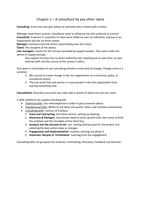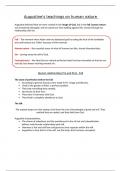CONSUMER BEHAVIOUR: CONCEPTS AND RESEARCH
METHODS – MCB-30306
LECTURE 1: INTRODUCTION TO THE COURSE
Determinants of consumer behaviour:
- Consumer characteristics that influence consumer behaviour
o Age, gender, people’s needs
- Product characteristics
o Taste, sustainability
- Situation characteristics
o Being in a rush, whether you’re alone/with family/with friends/etc.
o Is often not being taken into account
- Process/relation aspects
o Relation between consumer and product is different in different
situations
What is (the study of) consumer behaviour?
- Study of the processes involved when individuals/groups
select/purchase/use/dispose of products/services/ideas/experiences to
satisfy needs/desires
o It’s not only about the products, but also about the services
- It is about understanding (and predicting) interlinkages between
consumers, products (don’t forget situations/context), and behaviours
- Different theories about the processes, including concepts like perception,
categorisation, values (goals)
- Different research methods to empirically apply and validate/test them
Theory/concepts Research methods
Quality perception Conjoint analysis
Consumer motivation, means-end Laddering
chain
Personal constructs to general Scale development
measures
Categorisation Perceptual mapping
Individual differences Clustering
In het context of basic marketing strategies, like:
- Market segmentation
- Product differentiation/positioning
- New-product development
First article: Van Trijp and Meulenberg:
1. Sketches relation between marketing management and consumer
behaviour in the context of foods in agribusiness
2. Refreshes knowledge
1
, o Consumer decision making
as Extended/Limited
Problem Solving and
Routinized Response
Behaviour
o Theory of Planned Behaviour
o Elaboration Likehood Model
Why study consumer behaviour:
- For marketing management =
o The art and science of choosing target markets and getting, keeping
and growing customers through creating, delivering and
communicating superior value. Because, the key to achieving
organizational goals consists of the company being more effective
than competitors in creating, delivering, and communicating
superior customer value to its chosen target markets. Meeting
customer needs profitability.
- And Public Policy (social marketing), and Consumer Organizations, etc.
- Marketing concepts involves:
o Market focus/consumer orientation requires consumer
understanding
Strategic understanding (what?): Which market segments can
be distinguished? What are the needs and wants of potential
buyers?
Tactical understanding (how?): How do potential buyers make
their product choice decisions? How do they react to
combinations of marketing instruments?
Market pull (push it to the consumer to sell it) instead
of technology push (more about people’s needs)
Understanding of effectiveness marking mix (how well?)
o Coordinating (between sales, marketing, R&D, throughout supply
chain)
o Profitability ( people, planet, profit)
Marketing management’s instruments and environment:
- Target in the middle
- Controllable instruments in
intermediate layers
- Uncontrollable environment on the
outside
2
,One marketing strategy: product differentiation/positioning:
- Objective is to form particular brand image in the mind of consumers
perception of your brand in people’s mind
o Relative to competing products
o In the mind of the customers
o Using all marketing mix elements (products, price, promotion, place)
- Also discussed in terms of Points of Parity and Points of Difference
- Ways of differentiation/positioning
o 1. Existing or new attribute
Increased battery time
o 2. Use or application
Typically, as 2nd or 3rd positioning to expand market
o 3. Product user
Harley Davidson motor cyclists
o 4. Product class
Breezers vs. beer or soft drinks
Extra soft ice cream with respect to ice or desserts
o 5. Competitor
Sony vs. Apple’s iPod
Getting the best possible consumer understanding:
- More consumer data
- Better consumer data requires superior methods
o How to reliably and validly measure what we think is necessary to
know?
- Better integration into understanding requires theories/concepts
o Beyond isolated facts
o Trigger new questions
- Better sharing of understanding
o Actionable dissemination throughout the whole chain
o Interaction between management, sales, marketing, R&D
o Iterative process
Second article: Van Kleef et al.:
1. Gives a tour on variety of research methods from the perspective of
opportunity identification in new product development (a marketing
strategy)
o Includes methods like laddering, conjoint analysis and compositional
perceptual mapping
2. Structures differences between research methods
3
, o Starting point for needs/wants elicitation
Familiar product, unfamiliar product, consumer
o Task format
No, single, multiple products
Measure perceptions, measure preferences, measure
associations
Indirect elicitation, direct elicitation (self-articulated)
Understand? Express? Willing?
Structured data collection, unstructured data collection
o Actionability
Characteristics, benefits, values
LECTURE 2: A CASE FOR THEORY DRIVEN CONSUMER RESEARCH
Matrix:
This is a data matrix, how your data is being structured. Many of the
techniques are about how you manipulate this data structure.
- Rows = respondents
o The rows in a data matrix are the different respondents
- Columns in a data matrix are the variables
o The things that you measure and assign value to
o Can be socio-demographic: age, family size, etc.
o Can be about attitudes: what someone’s attitude towards something
is
Is done with a number of statements
You can group the individuals into segments (maybe you have 1000 individuals,
put into 5 segments). Then the matrix is collapsed into less rows.
Short recap:
- Consumer behaviour provides insight for policy and strategy
o Central to the marketing philosophy
- Now more critical to market success than before
o Changing market conditions consumers are demanding
- Require more detailed insight
o Both as input and as output of our marketing & policy decisions
- Consumer behaviour skills and competencies play a role at various levels
in the organization
o Strategic, tactical and marketing mix evaluation
A broad spectrum of issues:
A lot of the research is focused on the consumer and should have a direct impact
on the marketing mix (product, place, price, promotion). A lot of the research is
done in het yellow circle. Also, a lot of research is done in the white circle, which
is the external environment. You then look at for example how the socio-cultural
environment is changing over time
or is different in different countries.
This is all part of consumer
behaviour.
4
METHODS – MCB-30306
LECTURE 1: INTRODUCTION TO THE COURSE
Determinants of consumer behaviour:
- Consumer characteristics that influence consumer behaviour
o Age, gender, people’s needs
- Product characteristics
o Taste, sustainability
- Situation characteristics
o Being in a rush, whether you’re alone/with family/with friends/etc.
o Is often not being taken into account
- Process/relation aspects
o Relation between consumer and product is different in different
situations
What is (the study of) consumer behaviour?
- Study of the processes involved when individuals/groups
select/purchase/use/dispose of products/services/ideas/experiences to
satisfy needs/desires
o It’s not only about the products, but also about the services
- It is about understanding (and predicting) interlinkages between
consumers, products (don’t forget situations/context), and behaviours
- Different theories about the processes, including concepts like perception,
categorisation, values (goals)
- Different research methods to empirically apply and validate/test them
Theory/concepts Research methods
Quality perception Conjoint analysis
Consumer motivation, means-end Laddering
chain
Personal constructs to general Scale development
measures
Categorisation Perceptual mapping
Individual differences Clustering
In het context of basic marketing strategies, like:
- Market segmentation
- Product differentiation/positioning
- New-product development
First article: Van Trijp and Meulenberg:
1. Sketches relation between marketing management and consumer
behaviour in the context of foods in agribusiness
2. Refreshes knowledge
1
, o Consumer decision making
as Extended/Limited
Problem Solving and
Routinized Response
Behaviour
o Theory of Planned Behaviour
o Elaboration Likehood Model
Why study consumer behaviour:
- For marketing management =
o The art and science of choosing target markets and getting, keeping
and growing customers through creating, delivering and
communicating superior value. Because, the key to achieving
organizational goals consists of the company being more effective
than competitors in creating, delivering, and communicating
superior customer value to its chosen target markets. Meeting
customer needs profitability.
- And Public Policy (social marketing), and Consumer Organizations, etc.
- Marketing concepts involves:
o Market focus/consumer orientation requires consumer
understanding
Strategic understanding (what?): Which market segments can
be distinguished? What are the needs and wants of potential
buyers?
Tactical understanding (how?): How do potential buyers make
their product choice decisions? How do they react to
combinations of marketing instruments?
Market pull (push it to the consumer to sell it) instead
of technology push (more about people’s needs)
Understanding of effectiveness marking mix (how well?)
o Coordinating (between sales, marketing, R&D, throughout supply
chain)
o Profitability ( people, planet, profit)
Marketing management’s instruments and environment:
- Target in the middle
- Controllable instruments in
intermediate layers
- Uncontrollable environment on the
outside
2
,One marketing strategy: product differentiation/positioning:
- Objective is to form particular brand image in the mind of consumers
perception of your brand in people’s mind
o Relative to competing products
o In the mind of the customers
o Using all marketing mix elements (products, price, promotion, place)
- Also discussed in terms of Points of Parity and Points of Difference
- Ways of differentiation/positioning
o 1. Existing or new attribute
Increased battery time
o 2. Use or application
Typically, as 2nd or 3rd positioning to expand market
o 3. Product user
Harley Davidson motor cyclists
o 4. Product class
Breezers vs. beer or soft drinks
Extra soft ice cream with respect to ice or desserts
o 5. Competitor
Sony vs. Apple’s iPod
Getting the best possible consumer understanding:
- More consumer data
- Better consumer data requires superior methods
o How to reliably and validly measure what we think is necessary to
know?
- Better integration into understanding requires theories/concepts
o Beyond isolated facts
o Trigger new questions
- Better sharing of understanding
o Actionable dissemination throughout the whole chain
o Interaction between management, sales, marketing, R&D
o Iterative process
Second article: Van Kleef et al.:
1. Gives a tour on variety of research methods from the perspective of
opportunity identification in new product development (a marketing
strategy)
o Includes methods like laddering, conjoint analysis and compositional
perceptual mapping
2. Structures differences between research methods
3
, o Starting point for needs/wants elicitation
Familiar product, unfamiliar product, consumer
o Task format
No, single, multiple products
Measure perceptions, measure preferences, measure
associations
Indirect elicitation, direct elicitation (self-articulated)
Understand? Express? Willing?
Structured data collection, unstructured data collection
o Actionability
Characteristics, benefits, values
LECTURE 2: A CASE FOR THEORY DRIVEN CONSUMER RESEARCH
Matrix:
This is a data matrix, how your data is being structured. Many of the
techniques are about how you manipulate this data structure.
- Rows = respondents
o The rows in a data matrix are the different respondents
- Columns in a data matrix are the variables
o The things that you measure and assign value to
o Can be socio-demographic: age, family size, etc.
o Can be about attitudes: what someone’s attitude towards something
is
Is done with a number of statements
You can group the individuals into segments (maybe you have 1000 individuals,
put into 5 segments). Then the matrix is collapsed into less rows.
Short recap:
- Consumer behaviour provides insight for policy and strategy
o Central to the marketing philosophy
- Now more critical to market success than before
o Changing market conditions consumers are demanding
- Require more detailed insight
o Both as input and as output of our marketing & policy decisions
- Consumer behaviour skills and competencies play a role at various levels
in the organization
o Strategic, tactical and marketing mix evaluation
A broad spectrum of issues:
A lot of the research is focused on the consumer and should have a direct impact
on the marketing mix (product, place, price, promotion). A lot of the research is
done in het yellow circle. Also, a lot of research is done in the white circle, which
is the external environment. You then look at for example how the socio-cultural
environment is changing over time
or is different in different countries.
This is all part of consumer
behaviour.
4










